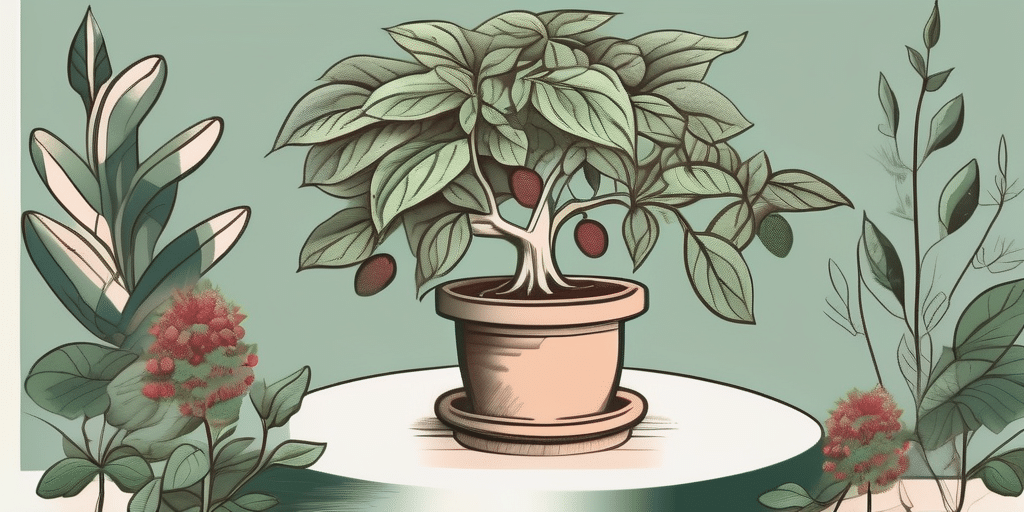Comfrey, also known as Symphytum officinale, is a versatile and beneficial herb that every gardener should consider growing. In this ultimate guide, we will explore everything you need to know about growing comfrey and maximizing its benefits in your garden.
Understanding Comfrey: An Overview
The History and Uses of Comfrey
Comfrey has a rich history dating back centuries. It has long been cherished for its medicinal properties and was traditionally used to heal wounds, reduce inflammation, and relieve pain. Comfrey leaves and roots contain allantoin, a compound known for its cell-regenerating properties.
Today, comfrey continues to be highly valued in alternative medicine and is commonly used in ointments, salves, and herbal remedies.
Comfrey’s versatility extends beyond its medicinal uses. In addition to its healing properties, comfrey is also valued in permaculture and organic gardening practices. Its deep taproot can mine nutrients from the soil, making it a valuable plant for composting and mulching. Comfrey is often used as a dynamic accumulator, pulling up minerals from deep within the soil and making them available to other plants when used as mulch.
The Different Varieties of Comfrey
Comfrey comes in several different varieties, each with its own unique characteristics. When choosing which variety to grow, consider factors such as desired usage, climate, and growing conditions. Some popular comfrey varieties include:
- Bocking 14
- Bocking 4
- Common Comfrey
- Russian Comfrey
Bocking 14 is known for its high levels of allantoin, making it a preferred choice for medicinal purposes. Bocking 4, on the other hand, is prized for its prolific growth and ability to quickly establish in a garden or permaculture setting. Common Comfrey, as the name suggests, is the most widely found variety and is often used for general gardening purposes. Russian Comfrey, also known as Symphytum x uplandicum, is a hybrid variety that combines the best traits of different comfrey species, making it a popular choice for permaculture enthusiasts looking for a versatile plant.
The Basics of Growing Comfrey
Ideal Soil Conditions for Comfrey
Comfrey, known for its deep taproot system, thrives in well-drained soil that is rich in organic matter. This perennial herb prefers a pH range of 6.0 to 7.0, although it can tolerate slightly acidic or alkaline conditions. Prior to planting, it is recommended to prepare the soil by removing weeds and incorporating compost or aged manure to provide the necessary nutrients for robust growth.
Additionally, comfrey is a dynamic accumulator, meaning it has the ability to draw up nutrients from deep within the soil and store them in its leaves. These nutrients can then be recycled back into the soil when the leaves are used as mulch or added to compost, making comfrey a valuable asset in sustainable gardening practices.
It’s important to note that comfrey is a heavy feeder and requires fertile soil to grow vigorously. Regularly amending the soil with organic matter such as compost, leaf mold, or well-rotted manure will ensure optimal growth and productivity, resulting in lush foliage and abundant harvests.
Sunlight and Watering Requirements
Comfrey is a resilient herb that can adapt to various lighting conditions, but it thrives best in full sun to partial shade. However, in regions with scorching temperatures, providing some afternoon shade can help prevent the plants from drying out or wilting, especially during the peak of summer.
When it comes to watering, comfrey enjoys consistently moist soil. While it can tolerate periods of drought, it will truly thrive with regular watering, especially during dry spells or prolonged heatwaves. Mulching around the base of the plants can help retain soil moisture and reduce the frequency of watering, promoting healthier root development and overall plant vitality.
Planting Your Comfrey
Comfrey, also known as Symphytum officinale, is a versatile and beneficial herb that is commonly used in permaculture and organic gardening practices. Its deep taproot mines nutrients from the soil, making it a valuable addition to any garden. When and how you plant your comfrey can significantly impact its growth and overall health.
When and How to Plant Comfrey
The best time to plant comfrey is in early spring after the last frost or in the fall before the first frost. This timing allows the plant to establish itself before extreme weather conditions set in. To propagate comfrey, you can choose to start from seeds or root divisions, depending on your preference and availability.
- If you opt for seeds, it’s beneficial to soak them in water for 24 hours before planting. This process helps to soften the seed coat and improve germination rates, giving your comfrey a head start in its growth journey.
- Whether you are sowing seeds or planting root divisions, ensure they are placed about 1 inch deep and spaced 12-18 inches apart. This spacing provides enough room for the plants to spread and thrive without competing for resources.
- After planting, water the comfrey thoroughly to help settle the soil around the roots and kickstart the growth process. Adequate moisture is crucial, especially during the initial stages of establishment.
- It is essential to keep the soil consistently moist until the seeds or root divisions establish themselves. This initial care and attention will set the foundation for healthy comfrey plants in the long run.
Tips for Seedling Care
Once the comfrey seedlings emerge, it’s important to thin them out to a spacing of 24-36 inches. This wider gap allows each plant to access ample sunlight, water, and nutrients, promoting robust growth and development. Additionally, applying a layer of organic mulch around the plants offers multiple benefits. The mulch helps retain moisture in the soil, suppresses weed growth that could compete with comfrey, and gradually breaks down to provide essential nutrients for the plants.
Maintaining Your Comfrey Plant
Comfrey, a resilient and fast-growing herb, requires regular care to thrive in your garden. In addition to pruning for manageability, it’s beneficial to provide adequate sunlight and well-draining soil for optimal growth. Comfrey’s deep taproot allows it to access nutrients from lower soil layers, making it a valuable addition to any garden.
When harvesting comfrey leaves, it’s important to select mature leaves that are rich in beneficial compounds such as allantoin and rosmarinic acid. These compounds contribute to comfrey’s healing properties, making it a popular choice for medicinal purposes. By harvesting older leaves multiple times a year, you can ensure a fresh supply of comfrey for various uses, including composting or creating herbal remedies.
Dealing with Pests and Diseases
While comfrey is known for its pest and disease resistance, occasional issues may arise that require attention. By staying vigilant and implementing proactive measures, you can maintain the health of your comfrey plants. Here are some strategies for addressing common comfrey pests and diseases:
- Slugs and snails: These common garden pests can damage comfrey leaves. To control their population, consider using organic slug pellets or manually removing them during the evening hours when they are most active.
- Aphids: These tiny insects can suck sap from comfrey plants, causing stunted growth. Combat aphids by spraying affected plants with a homemade insecticidal soap or introducing natural predators like ladybugs, which feed on aphids.
- Powdery mildew: This fungal disease can affect comfrey plants, especially in humid conditions. To prevent powdery mildew, ensure good air circulation around the plants by spacing them appropriately. Additionally, avoid overhead watering, as moisture on the leaves can promote the growth of this fungal infection.
Using Comfrey in Your Garden
Benefits of Comfrey for Soil Health
Comfrey is often called a “dynamic accumulator” due to its ability to draw up nutrients from deep within the soil and store them in its leaves. When these leaves decompose, they release valuable nutrients, making comfrey an excellent addition to compost piles or as a mulching material.
Additionally, the deep root system of comfrey helps improve soil structure, aerate the soil, and promote beneficial microbial activity.
Comfrey’s nutrient-rich leaves are not only beneficial for soil health but also for supporting pollinators in your garden. The nectar-rich flowers of comfrey attract bees, butterflies, and other beneficial insects, enhancing biodiversity and promoting a thriving ecosystem within your garden.
Comfrey as a Companion Plant
Comfrey’s deep taproots make it an excellent choice as a companion plant in the garden. The taproots help break up compacted soil, allowing air and water to reach the roots of nearby plants.
Furthermore, comfrey’s large leaves provide shade to moisture-sensitive plants and act as a living mulch that suppresses weed growth.
Now that you have a comprehensive understanding of growing comfrey, it’s time to put your knowledge into action and start reaping the benefits of this versatile herb. Whether you plan to use it for medicinal purposes or to improve your garden’s health, comfrey is sure to become an invaluable addition to your gardening endeavors.
Join Our Green-Thumbed Community!
Ready to transform your garden with the power of comfrey and more? Subscribe for free to How to Grow Everything and learn how to build the garden of your dreams! Receive personalized gardening advice tailored to your specific location, grow zone, and experience level. Enjoy the best gardening tips, special offers, and deals delivered straight to your inbox—no spam, just pure gardening gold. Join our family of passionate gardeners and start growing your knowledge today!





